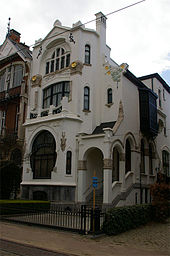- Zurenborg
-
Zurenborg is an area in south-east Antwerp largely developed between 1894 and 1906 that features a high concentration of townhouses in Art Nouveau and other fin-de-siècle styles.[1]
Zurenborg is unique in Antwerp in the sense that it is one of the few areas developed according an urbanistic plan in the late 19th century.
Contents
Houses in Zurenborg
Location
Art Nouveau houses are interspersed with neoclassical mansions and other eclectic architectural styles throughout Zurenborg, which is geographically split between Antwerp itself and the district of Berchem. The southern part, which falls within Berchem and is centred along Cogels-Osylei (or Cogels-Osy Lei), Transvaalstraat, and Waterloostraat, has the highest number of townhouses. To the north, in the Antwerp section, many further examples were built along the streets surrounding Dageraadplaats.[1]
Styles
The development of Zurenborg coincided with the peak of Art Nouveau popularity, and that movement had the greatest impact on the stylistic language of the area.[1] However, many other styles—mostly "revival styles"—that were popular at the time are also represented. These include Gothic Revival, Neo-Renaissance, Greek Revival, Neoclassical, and the "cottage style" that coincided with British Tudorbethan architecture.
Themes
The houses were often named and decorated with accompanying themes.[1] The influence of organic and natural sources is particularly evident in the themes and names of the Art Nouveau homes: The Sunflower, The Rose, The Tulip, etc. Houses also referenced local history or the names of the streets upon which they stand. The "Lion of Flanders" prominently adorns Cogels-Osylei 2–4, while across the street an entire complex is devoted to Charlemagne. Some street names refer to the independence war of linguistic affinity, the Boer war in South Africa: Pretoriastraat, Transvallstraat [1] and Krugerstraat. On Waterloostraat [2] ("Waterloo Street") houses recall the eponymous battle of the street's name. One, Waterloostraat 30, is adorned with a silhouette of Napoleon in his characteristic headgear, while another is decorated with glazed ceramic panels depicting scenes from that battle. The facade of house Nr.11, The Battle of Waterloo, shows the portraits of Wellington and Napoleon, the two great commanders of the age. Bayonets, flags, smoking canons and drums show you clearly the subject of the house.
Co-ordination of houses
Groups of individual houses were sometimes combined to form a general theme and are intended to be experienced as co-ordinated designs rather than as individual units.[1] Such an ensemble are the five adjoining houses collectively known as De Tijd (Time) on Waterloostraat. Each one, built in brick and in contrasting colours, is named for—and thematically represents—a time of the day: Ochtend (Morning), Dag (Day), Avond (Evening) and Nacht (Night). Similarly, some of the structures "speak" to one another. Examples of such a grouping are on the four corners of the Waterloostraat and Generaal Merlenstraat intersection. There, houses depicting the four seasons face one another: Lente (Spring), Zomer (Summer), Herfst (Autumn) and Winter.
Architects
Several architects worked in the neighbourhood. Among them was Joseph Bascourt, who designed 25 of the houses,[2] Jules Hofman, and Frans Smet-Verhas.[1]
Post World War II history
With car ownership rising and upper middle class households moving to the suburbs, the status of Zurenborg - especially Cogels Osylei - as well to residential area came down. The houses were regarded as too big and too much energy consuming. A major plan was made in the 1960s to transform the whole area into a business and office area similar to the one built at Brussels North station. In the end - however - it was concluded that the area was not to be demolished. From one day to another, the area became listed as urban landscape at disappointment of many owners who expected to sell their property at a profit.
The area became popular for artists, and entrepreneurs. Many houses became listed monuments. With support of public subsidies, many owners succeeded to renovate their properties and Zurenborg became an example of a well functioning urban neighbourhood with a varied mixture of people. The Dageraadplaats square in the north section of Zurenborg transformed from a neighbourhood shopping area into one of the most popular dining areas in Antwerp, and the art nouveau manions in Zurenborg draw high numbers of visitors and tourists.
Parts of Zurenborg - especially Cogels Osylei and Wolfstraat - are extensively suffering of intensive heavy bus traffic for many years causing pollution and vibrances, with some loss of external and internal ornaments as a result.
Gallery
-
"Boreas" house, Transvaalstraat 56. Architect: Joseph Bascourt
References
- ^ a b c d e f Alex Elaut, Zurenborg Walk, Antwerp: Toerisme Antwerpen, [n.d.].
- ^ Anne van Loo, "Bascourt, Joseph," Grove Art Online, Oxford University Press. [accessed 11 April 2008]
External links
Categories:- Art Nouveau buildings
- Districts of Antwerp
Wikimedia Foundation. 2010.







